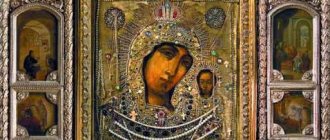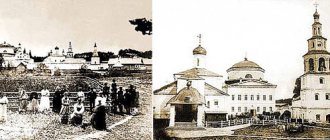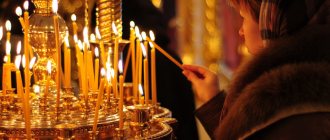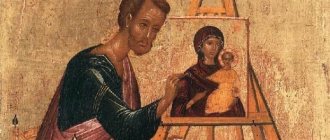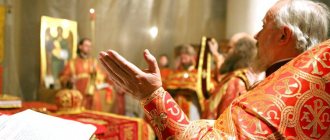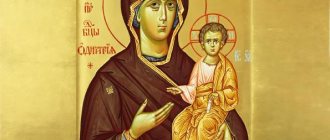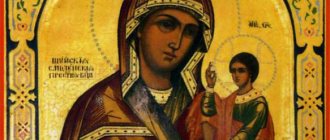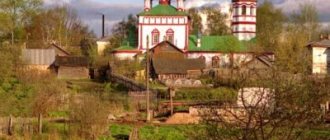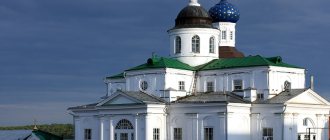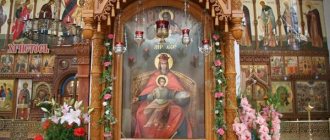Hodegetria - what is it?
Where did this image come from? According to legend, it was originally written by the Apostle Luke during the life of the Mother of God. This image, which later became known as the Mother of God Hodegetria, was sent to Constantinople in the fifth century. For a long time he was in the Odegon monastery. Some researchers believe that this icon was a copy from Blachernae. That first image also contained a small part of the Mother of God’s maphoria.
Today, the Tretyakov Gallery houses one of the oldest such images, which remains as it was before. This icon originates from Pskov and dates back to the end of the 13th century. Previously, it was located in the Church of St. Nicholas of Kozh.
It should be noted that the name of this image has its own legend. According to it, the Mother of God appeared before two blind men and in some incomprehensible way led them to the temple in Blachernae. She placed the sufferers in front of the icon of the same name, and they began to see clearly. Since then, this image has received the name “Hodegetria”, which is translated from Greek as “guidebook”.
According to another legend, the icon became a blessing for the wedding of Anna, who was the daughter of the Greek emperor Constantine Porphyrogenitus. After a long journey to Rus', it acquired its name.
"Hodegetria" in Rus'
The icon came to the territory of present-day Russia somewhere in the middle of the 11th century. She was brought by Princess Anna, who after some time became the wife of Vsevolod Yaroslavich of Chernigov. This image was originally miraculous and enjoyed special veneration by Christians. After some time, the “Hodegetria” icon of the Mother of God began to be called Smolensk.
Many copies of this icon quickly spread throughout Rus'. Of course, the image itself underwent some changes, since there was no strict iconographic canon for this type of Mother of God, and no one demanded an exact copy of the shrine. However, the general features of the icon were preserved.
Text of the prayer before the icon of the Mother of God “Hodegetria of Baital”
A special prayer for the holy face of the Mother of God “Hodegetria of Baital” has not yet been written. But there are many prayer texts read in front of icons belonging to the Hodegetria iconographic type. .
One such sacred text is given below:
“Oh, Most Wonderful and Above All Creatures, Queen Theotokos, Mother of the Heavenly King Christ our God, Most Holy Hodegetria Mary! Hear us, sinners and unworthy, at this hour praying to You with sighs and tears before Your Most Pure Image, and tenderly saying: lead us from the pit of passions, good Hodegetria, deliver us from all sorrow and sorrow, protect us from all misfortune and evil slander and from the unrighteous slander of the enemy: you can, O our Gracious Mother, not only save Your people from all evil, but also provide and save Your people with every good deed. Are there other intercessors for You in troubles and circumstances and warm intercessors for us sinners to Your Son, Christ our God, who are not imams? Pray to Him, Lady, to save us and grant us the Kingdom of Heaven, so that through Your salvation we may glorify Thee in the future, as the author of our salvation, and extol the All-Holy and Magnificent name of the Father and the Son and the Holy Spirit, glorified and worshiped God in the Trinity, forever and ever. . Amen".
Special attitude towards the Mother of God in Rus'
So, the Hodegetria icon in Rus' is quite popular and very revered. Evidence of this is the numerous lists of the first image that spread throughout Ancient Rus'. It should be noted that the Mother of God is favorable to people living in this territory, since in many areas she is considered a patroness and intercessor.
Very often, sincere prayer saved a person from some misfortune or misfortune. There is a lot of evidence of this, both in ancient times and today.
Iconography of the image
The Hodegetria icon is a special image of the Mother of God. Translated from Greek, as already mentioned, this is a “guidebook”. The icon has special meaning for Christians. This image usually depicts the Mother of God and Child. Her hand is a finger pointing to the Son (located in front of the chest), as well as to the salvation of all mankind. This point is very important. The Baby himself sits on his left hand. His left hand is occupied with a rolled scroll, and his right is raised in a gesture of blessing. The Baby's legs are either crossed or straight. Usually the Son is depicted frontally, but sometimes he can be drawn half-turned. In any case, the blessing gesture is preserved. The Virgin Mary is sometimes depicted on a throne, sometimes in full height or waist-deep.
It should be noted that this image was known for quite a long time, even before the 6th century, in Palestine and Egypt. After which it became widespread throughout the Orthodox East. In the 3rd century, a theological understanding of this image took place, namely the interpretation of the moment of the Incarnation of God by the Mother of God. It should be noted that it is from this plot that new ones emerge that are directly related to the Mother of God. This is “The Burning Bush”, and “The Unbreakable Wall”, and many others.
Description and meaning of the icon of the Mother of God “Hodegetria of Baital”
On the Baital Icon, the Mother of God is represented from the waist up, with Jesus Christ sitting on her left hand.
The Baital image is made in a manner typical of most prototypes of Hodegetria:
- The Savior is depicted in adolescence;
- Our Lady and Christ look at those praying;
- With his left hand the Savior squeezes a rolled scroll, with his right hand he blesses the believers;
- the right hand of the Mother of God points to the Son, as if pointing the way to God and eternal salvation.
The clothes on the holy faces are red. Jesus Christ wears a red tunic over a white shirt. The scarlet maforia, covering the head and entire body of the Virgin Mary, is worn over a blue tunic. Three stars are painted on the maforia (on the forehead and shoulders), symbolizing the virginity of the Queen of Heaven.
On the Baital icon, the central role is given to Jesus Christ, who is the Almighty Savior, Heavenly King and Judge.
The face of the Blessed Virgin Mary is sad and filled with sorrow. But, despite this, the holy image leaves a feeling of hope and faith in the imminent resurrection. The Mother of God looks older than her years, since the icon painter’s goal was to show not a young girl, but the Mother of God, wise in life, providing spiritual support to Christian believers.
The image of the Baital Hodegetria is placed under glass, on top of which hang chains made of golden metal. Large crosses made of the same metal hang from the chains.
The Smolensk icon is the most popular for this type
The icon “Hodegetria of Smolensk” is considered the prototype of all similar icons in Rus'. Its history goes back centuries, but these are mostly legends that were passed down from mouth to mouth. It is believed that it is a copy of the first icon that was painted by the Apostle Luke. She came to Rus', as was written above, with the daughter of Emperor Constantine.
After Prince Vsevolod Yaroslavovich and his wife Anna died, the icon was inherited by their son, Vladimir Monomakh. He transferred the miraculous image to Smolensk and placed it in the Church of the Dormition of the Virgin Mary. Since then, the icon has become Smolensk.
In terms of the number of miracles performed, she is in one of the first places among her kind. It was the “Mother of God Hodegetria of Smolensk” in 1239 who was the intercessor and savior of the Russian land from the invasion of the troops of Batu Khan.
At the beginning of the 15th century, the icon was moved to Moscow and placed in the Kremlin in the Annunciation Cathedral. After some time, she was returned to her homeland, to Smolensk. After this, the image made many more travels and migrations, especially during wars and aggressive actions, but always returned to its homeland. Unfortunately, after the events of World War II, the fate of the image is unknown.
At one time, many copies were written from this icon, which spread throughout Russia. In Smolensk, in place of the ancient icon there is now another one, which also has miraculous properties. It is considered one of the most important shrines of the Russian land.
Tikhvin icon
Along with the Smolensk image, the “Tikhvin Hodegetria” is also revered. The Icon of the Mother of God has the same ancient history, during which there were miraculous moments. It is believed that the image disappeared from Constantinople after its fall, and some time later appeared in Russia near Tikhvin.
According to legend, the Patriarch of Constantinople himself said that this is the same icon that was once in the Blachernae Church. In the Tikhvin Monastery the image was placed in the same way as originally in the temple of Constantinople. He stayed there all the time until monasteries and churches began to close throughout the country (USSR times).
During the Soviet years, the icon was in America, and since 2004 it returned to Russia, where the Tikhvin Monastery began to be recreated.
Pilgrim's Reminder
Dear pilgrim!
For centuries, the heart of an Orthodox Russian person has always longed to touch the Holy Places. His strong faith, his love for God were always looking for something that could satisfy his tired soul. Prayer, fasting, and good deeds were in first place for him. And just as a tired traveler looks for a place of rest, so a believing Christian stops where he can satisfy his spiritual hunger.
Holy places, inspired by the exploits of our Lord, His Most Pure Mother, devotees of piety and holy martyrs and confessors, always filled his heart with a special feeling of tenderness and reverence. An Orthodox person expressed his love for God and for the Holy People of God by visiting holy places.
For two thousand years, Christians have known the gracious power of prayer in front of miraculous icons, the special help of God's saints in life's difficulties and aspirations, and the healing power of Holy Springs. Hundreds of miraculous icons of the Most Holy Theotokos and Saints of God are known in Rus'.
In our time of spiritual sobering up from almost a century of spiritual hibernation, many of our compatriots are returning to the bosom of the Orthodox Mother Church. There are more and more new Christians who sincerely want to touch the Holy Places.
If you are planning a trip to Holy Places, then keep in mind that temptations await you: no good deed can happen without trials. Especially in Holy places. Temptations can begin already when preparing for a trip: You may forget your prayer book, or forget that you wanted to receive Holy Communion, and on the road you took something meat or ate ice cream. All this can happen, so be careful and take some advice from us.
Since you are preparing to travel along the pilgrimage route, you should understand the difference between a travel agency and a pilgrimage service. The goal of any travel company is to satisfy the cognitive interests of clients with the provision of the optimal volume of services to obtain actual financial or other material benefits. The goal of the Orthodox Pilgrimage Service is to assist everyone in visiting Holy Places at minimal financial cost: not for the sake of money, but for the benefit... Pilgrimage involves attending services, excursions and bathing in Holy Springs, and, if possible, visiting museums and historical monuments.
Tips for a pilgrim:
Since our trip is a pilgrimage and not a tourist one, the dress code for women is the same as for the Temple - skirts and scarves. Men should not wear shorts, and women should not wear trousers, short skirts, open dresses, blouses, T-shirts, etc. Women are not allowed to enter an Orthodox monastery with their heads uncovered, nor are they allowed to wear cosmetics.
Upon entering the temple, one should venerate the locally revered Shrines - miraculous icons, the Holy relics of the saints of God. After praying, you can venerate the Holy Relics, but you cannot kiss the face on the icons. It is customary for the Savior to kiss his hand; on the icon of the Mother of God and the Saints they kiss either the hand, or the edge of the robe, or just a corner of the icon. If the icons contain a reliquary, it is customary to venerate the Holy relics.
It is better to approach the icons and light candles either before the start of the service or after it ends. During the Eucharistic canon and reading of the Gospel, one should refrain from passing candles.
You cannot talk loudly in churches, especially during divine services.
The conditions of communication, accommodation and behavior on our trips are pilgrimage, Orthodox. Men and women spend the night separately.
When getting off the bus, take money and documents with you just in case (especially if you are traveling alone). As a rule, when visiting holy places, pilgrims are given free time. Use it as you wish, but don't get carried away - don't wander too far. You need to arrive at the group meeting place at the specified time so as not to make others wait for you. If you need to leave, please inform the group leader.
On multi-day trips, you can take packed lunches with you. It may be useful to take a boiler and a thermos with boiling water with you. Do not take perishable food - there is usually no refrigerator on the bus. It is better to take mugs with lids and not fill them to the top - after all, a bus is not a train, it shakes more.
You can take wet sanitary wipes with you on the road - wiping your face and hands once again won’t hurt. A water bottle can also be helpful.
It’s good to have a raincoat or umbrella with you - getting wet and catching a cold during the trip is not at all advisable. And, of course, comfortable shoes are required. Take soft, familiar shoes on the road, preferably with thick soles. The same applies to clothing - for traveling and exploring holy places, it is better to dress simply, but comfortably. Don't forget about warm clothes depending on the time of year.
It is useful to take books: prayer book, psalter. In addition, the icon of the Mother of God “Hodegetria” (Guide) or St. Nicholas the Wonderworker, the patron saint of travelers, as well as containers for holy water and blessed oil.
We recommend taking with you medicines for headaches, against colds, for the treatment of the gastrointestinal tract (changes in climate and water can lead to undesirable results), a bactericidal patch, because... I'll have to walk a lot and take allergy medication. If you have any chronic illnesses, take the medications you need from home.
If you are just getting into church, then do not hesitate to come with us. You do not have to attend long monastic services and endure all the “hardships” of pilgrimage life. While the main group is in the Temple, you can take a walk, look at our Shrines and the surroundings of the wonderful places we will visit.
On a pilgrimage trip it is unacceptable: drinking alcoholic beverages; playing cards and other games of chance; rudeness and obscene language; You cannot sing or listen to non-spiritual music. The manager has the right to remove malicious violators of public discipline from the trip without financial compensation.
For your safety and the safety of the pilgrims around you, it is not blessed to take things from strangers for storage or for subsequent transfer to someone else.
Depending on weather conditions, availability of time and solving technical problems, it is possible to make changes to the route schedule, which the pilgrim can learn about on the eve of the excursion day.
Do I need to take extra money with me? Pilgrims act prudently and save money in order to order a commemoration of their loved ones at the Divine Service.
The price of a pilgrimage ticket includes: travel (by bus), excursion services and assistance along the entire route. Therefore, as a rule, no additional payments will be required. Exceptions are made in individual cases, but these will be announced in advance.
But what you definitely should have is patience and humility.
We remind you: you are going to Holy places - this does not happen without temptations!
And the surest way to get rid of problems is prayer.
On a pilgrimage trip you must take with you:
Day Trip:
- Container for holy water;
- A shirt (nightgown) for dipping (if there is a source) - for pilgrims.
- Food on the road;
- The most comfortable shoes (preferably without heels);
Multi-day trip - added to the above list:
- Passport (birth certificate);
- Bed linen (2 sheets) - not for all trips;
- Warm clothes, incl. raincoat;
- For comfort on the bus - a small pillow, a blanket;
When visiting Orthodox shrines, it is necessary to observe the norms of Christian ethics:
- It is necessary to have a pectoral cross.
- Clothing should be loose, not tight, seasonal;
- Men should not wear shorts or sleeveless T-shirts.
- Women should have a skirt below the knees, without high slits, a headscarf, and a long-sleeved jacket. It is not recommended to use cosmetics.
It is necessary to remember and follow the rules of behavior on the road:
- Cleanliness on the bus.
- At stops, do not cross the road through oncoming traffic.
- Remember that the trip is a pilgrimage and the most important thing in it is obedience.
- For any questions, please contact the group leader.
Kazan icon
Another famous “Our Lady Hodegetria” is located in Kazan. This icon was found in 1579 in the city of Kazan, after there was a terrible fire that destroyed almost the entire settlement. The image of the Mother of God was revealed to a little girl, who dug the icon out from under the ashes.
The miraculous acquisition of the image after a terrible tragedy struck everyone very much. Many at that time went to worship her, she gave hope for salvation (after all, cold weather was setting in, and many people were left on the street, without shelter or any property).
Subsequently, at the behest of Ivan the Terrible, the Kazan Cathedral was built, and a convent was founded near it. Miracles began to happen near the icon immediately after its discovery (the sight of two blind men).
Today the original icon does not exist; after some time it was lost. However, numerous lists from it still exist today, famous for their miracles.
How does the holy image help?
After the discovery of the ancient icon, many healings were recorded that occurred through prayers to the miraculous image. Miraculous events occurred in many families from different cities of Ukraine and Russia: Kyiv, Odessa, Dnepropetrovsk, Moscow, Polotsk, Yaroslavl, Tyumen.
Numerous cases of cure for infertility have been observed. Women who were unable to conceive a child for a long time were able to become pregnant and find the happiness of motherhood.
But people turn to the Baital shrine not only for healing. The miraculous image helps:
- solve housing issues;
- resolve work problems;
- return lost daughters and sons to their families;
- successfully complete litigation.
People's love for the ancient image prompted the Mother of God to illuminate her holy face on the Baital icon.
Other famous icons of this type
The Hodegetria of Smolensk icon is, of course, the most famous among others of this type. However, there are many others similar to it. One of these icons is the Georgian one. Initially, it was in Georgia, but after 1622 it was taken to Persia (after the conquest of the country by Shah Abbas). Her journey was long, and it stopped in the Arkhangelsk province at the Krasnogorsk monastery. Today, the original image is lost, but there are copies of it. Prayers are offered in front of the icon for the sake of deliverance from various epidemics, as well as to be cured of ear and eye diseases.
Another, no less important, icon depicting the Mother of God Hodegetria is the Iverskaya. This image has an equally mysterious history. In the 9th century, she was in the house of a pious woman. It was an iconoclastic period, and she decided to save the icon from destruction by lowering it into the waters of the sea. The icon appeared only two centuries later near Mount Athos near the Iveron Monastery. A gate church was built for her, where the image is still preserved.
Of course, these are not all the images of this type, which are kept and revered in many monasteries and temples. There are quite a few of them, and they all have their own special powers and provide protection.
Temples dedicated to the image of Hodegetria
Having considered the question: “Hodegetria - what is it?” — it should be noted that other shrines also correspond to this image. For example, in many cities both in Russia and other countries, there are temples that were built in honor of the image of the “Guide”. Let's look at the list:
- church in Kimzha, located in the Arkhangelsk region (not active);
- church in the city of Disna, Belarus (operating);
- chapel-temple of Hodegetria, it is located in Simferopol, Crimea (operating);
- Church in Kasimov, located in the Ryazan region (operating).
And there are quite a large number of such churches, chapels and temples, since the veneration of the Mother of God by the Orthodox is great.
Veneration of the miraculous icon in Orthodoxy
The miraculous Baital Hodegetria is given many honors. Not far from the temple, it was possible to restore one of the healing springs. Thanks to Baital village head Natalya Gredenyuk, the narrow path leading to the spring has been replaced by a normal road. On the initiative of the local priest, a chapel-bath named after the Holy Passion-Bearers was immediately built, intended for bathing pilgrims in healing water.
Since 2012, the ancient shrine began to flow myrrh. A special oak iconostasis was made for the myrrh-streaming icon. Over the course of several years, the icon itself and its copies visited many dioceses in religious processions. Solemn prayer services were held in every city. Hundreds of people came to worship the holy image, patiently standing in kilometer-long queues to the shrine.
